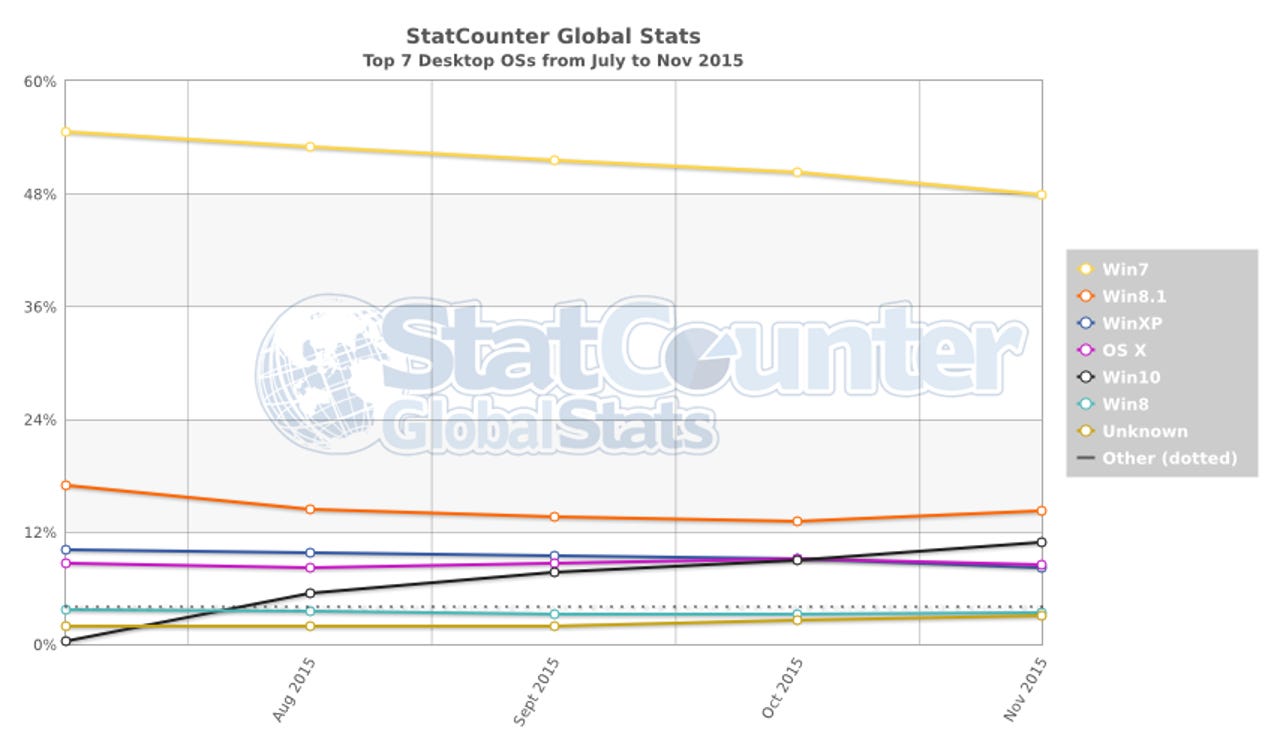How long before Windows 10 overtakes XP - or has it already?

Netmarketshare says Windows 10 had a market share of around 8 percent in October 2015. So, if there are 120 million PCs running Windows 10, the installed base must be 1.5 billion, which is the number often quoted. Roughly 300 million PCs are sold each year, which suggests an average lifespan of about five years. (Annual PC sales would be much higher if they only lasted 2-3 years, but the business refresh cycle isn't what it used to be.)
And since Windows XP has a market share of roughly 12 percent, there must be around 180 million PCs still running XP (ie 12 percent of 1.5 billion). Netmarketshare's actual number is 11.68 percent, which is 175.2 million. The fact that there's less than 5m difference shows just how pointless it is to look at any of these numbers to two places of decimals. They're not that accurate.
So, when will Windows 10 overtake XP?
That it depends on two unknowns: how quickly Windows 10 grows, and how quickly XP shrinks.
We can certainly expect Windows 10 to keep growing, particularly after Windows 10 laptops replace Windows 8.1 machines in the shops. However, we'd expect the number of free upgrades to taper off, because those who are keen to upgrade will upgrade faster than those who are not keen. We can also ignore mass corporate installations, because they're not going to kick in for a year or two. Indeed, I expect many companies to hang on to Windows 7 until 2020.
Still, if Microsoft can keep Windows 10 growing by 15 million units per month - not an unreasonable number - then its market share should grow by 1 percent per month. If that happens, Windows 10 will overtake XP in four months, ie in March 2016.
Of course, if Windows XP's market share shrinks, it will happen before then.
Unfortunately, we don't have a good grip on XP's decline. Readers with good memories will recall that Netmarketshare got XP's market share badly wrong by counting some large Chinese websites where XP was the dominant operating system ("nearly 100%"). Towards the end of last year, it adjusted the numbers, knocking more than 10 percent off XP's share in only two months. This year's numbers have been smoother, but XP has apparently increased its market share in three reports, which I find impossible to believe. (That's another reason to ignore those decimals.)
In ball-park terms, XP has been losing around half a percentage point per month, over the past 12 months. If this trend continues, then Windows 10 could overtake XP in the January numbers, released on February 1, with a score of 11.0 percent vs 10.5 percent.
In the best imaginable case - Windows 10 grows by 2 percent a month while XP shrinks by 1 percent a month - Windows 10 will be ahead by Christmas. I would bet against that, but you can make your own calculation.
Either way, Windows 10 should have overtaken XP by the end of the financial year, though we must always remember the old saying that "prediction is difficult, especially about the future".
Windows 10 is already ahead, on a different measure.
Statcounter produces alternative market share figures based on the number of website visits, rather than the number of unique user PCs. Even if there aren't as many Windows 10 PCs, they are doing more surfing.
Statcounter's numbers show Windows 10 growing from zero to 5.38 percent in August, via 7.64 percent in September and 9 percent in October to 10.82 percent now. Over the same period, XP declined from 10 percent in July to 8.21 percent now. XP's market share has shrunk to the point where it is almost the same as all versions of Mac OS X combined (8.46 percent).
The more surprising thing is the rapid decline of Windows 7, from 54.64 percent in July 2015 to 47.81 percent now. If Statcounter is correct, Windows 7's usage has been falling faster than Windows 8.1's, which has only dropped a couple of points from 16.84 percent to 14.22 percent. Windows 8 has fallen from 3.68 percent to 3.35 percent, which is basically unchanged.
Perhaps Statcounter's numbers are wrong. but if they are correct, I wouldn't have predicted that. I expected Windows 8.1 users to shift in droves, and Windows 7 users to hang on for as long as possible. That's how I did my Windows 10 upgrades. How about you?
